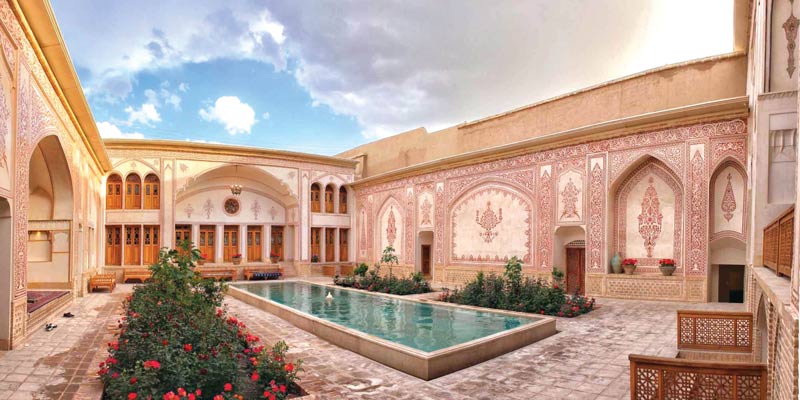Iranian Persian architecture is the architecture of contemporary Iran and the Iranian Cultural Continent. It has a continuous history from at least 5000 BCE to the present and generally displays great variety, both structural and aesthetic, developing gradually and coherently out of earlier traditions and experiences. Persian buildings vary from peasant huts to tea houses and gardens, pavilions to “some of the most majestic structures the world has ever seen.
Arthur Upham Pop-e
(1881–1969) a best-known American expert on Persian/Iranian art and the editor of the authoritative Survey of Persian Art- says: “The supreme Iranian Art, in the proper meaning of the word, has always been its architecture. The supremacy of architecture applies to both pre-and post-Islamic periods.”
In this architecture, “there are no trivial buildings; even garden pavilions have nobility and dignity, and the humblest caravanserais generally have charm. In expressiveness and communicatively, most Persian buildings are lucid – even eloquent. The combination of intensity and simplicity of form provides immediacy, while ornament and, often, subtle proportions reward sustained observation.

Iran’s traditional houses architecture
The architecture of Iranian traditional houses has manifested native-traditional models of the past history of Iran which have originated from individual and collective cultures of the people, who have been formed, have grown, have been manifested, and have reached perfection.
It is the architecture employed by builders and craftsmen in the cultural Greater Iran. The art draws from various cultures and elements from both Islamic and pre-Islamic times. The roots of the principles governing traditional architecture can be found in Iranian thoughts and culture. On the basis of religious and traditional ideas of the Iranian families, House is not only a shelter and the human being doesn’t only live under a ceiling and on some sq. meters. spatial flexibility, legibility, introversion, spatial hierarchy, and respecting family privacy had had a special position in the architecture of Iranian houses
Thus the houses have a kind of internal spaces structure and an innate system of protection; they all have enclosed gardens with maximum privacy, preventing any view into the house from the outside world. Climate, too, has affected this architecture. In other words, being situated on the edge of deserts and arid regions, Persian (Iranian) cities typically have hot summers, and cold, dry winters.
Persian architecture Persian architecture Persian architecture Persian architecture Persian architecture Persian architecture
Almost all traditional Persian houses have these elements:
On two sides of the entrance door, there is a place for taking a rest while waiting, for entrance, or talking with the neighbor. This place is called Platform (Sekonchei).
Many old houses in Iran have paired wooden entrance doors with two different knockers on each pair. This difference refers to the voice of the knockers so that the knocker with a low voice is used by the women and the Hammer knocker is used by men. As a result, the people who were in the home realized the gender of the person who is behind the door.
Hashti ( Dalan-e-vorudi) or Vestibule is a space with a short ceiling and an octagon or tetragon form, immediately after the entrance door to the building.
The connection space between the Hashti and the Yard is called the corridor.
The yard is a central pool, or how with surrounding gardens containing trees of figs, pomegranates, and grape vines.
Rooms in Old Persian houses had been constructed in a way that some of them were in the southern part of the home and about 7-8 m below ground surface with low light. In these rooms, the Sun didn’t shine and so they were cool and suitable for summer. Winter rooms, too, were in the northern part of the house and had enjoyed adequate sunshine throughout the winter season.
Reception Hall is the main room of the house with abundant decorations and designs and is linked to the yard of the house with five-door and seven-door sashes. Because of this, Panjdari is another name for this room.
Persian architecture Persian architecture Persian architecture Persian architecture Persian architecture Persian architecture
The house of rich people in Iran has two separate Biruni (exterior) and the andaruni (interior) parts. The last belonged to female members of the family while the first was the male quarter of the house. The Biruni was less furnished than the andar?n?; but both parts had courtyards planted with fruit trees, shrubs, and flowers and set with pools and fountains.
Iranian Persian architecture is the architecture of contemporary Iran and the Iranian Cultural Continen
Furthermore, Persian houses in central Iran were designed to make use of an ingenious system of wind catchers or Badgirs that create unusually cool temperatures in the lower levels of the building. Thick massive walls were designed to keep the sun’s heat out in the summertime while retaining the internal heat in the winter.
Important Iran traditional houses
Tehran
Torabi House
Pirnia House
Fakhr-Ol- Molook House
Moein –O Tojar Boushehri House
Anis o doleh House
Imam Jome House
Jalal House
Malek House
Iirvani House
Sultan Beigom Shojae House
Moghadam House
Kashan
Boroujerdi House
Hosseini House
Tahami House
Taj House
Bani Kazemi House
Shoaei House
Sadeghi House
Manouchehri House
Tabatabaie House
Balal House
Baku Chi House
Hakim Bashi House
Isfahanian House
Falahati House
Hashemiyan House
Ameriha House
Akhbari House
Ehsan House
Sodoori House
Sharifian House
Bala Khane Chi House
Attarha House
Abbasian House
Isfahan
Bekhradi House
Dibai House
David House
Dastjerdi House
Arastooye House
Naalbandha House
Sheikh-o- leslam House
Ghasemi House
Ghodseeye House
Marta peres House
Angoorestane malek House
Sun Rise House
Mashrooteh House
Aalam House
Sartipi House
Pirnia House
Yazd
Rasoolyan House
Fahadan House
Mozafar House
Koorosh House
Sabat House
Lariiha House
Alayee House
Emam Zadeyee House
Omid Salar House
Arbabo House
Mortaz House
Saraf Zadeh House
Malekzadeh House
Mahmoodi House
Navab Razavi House
Kolahdoozha House
Shiraz
Shapouri House
Zinat-ol- Molk House


